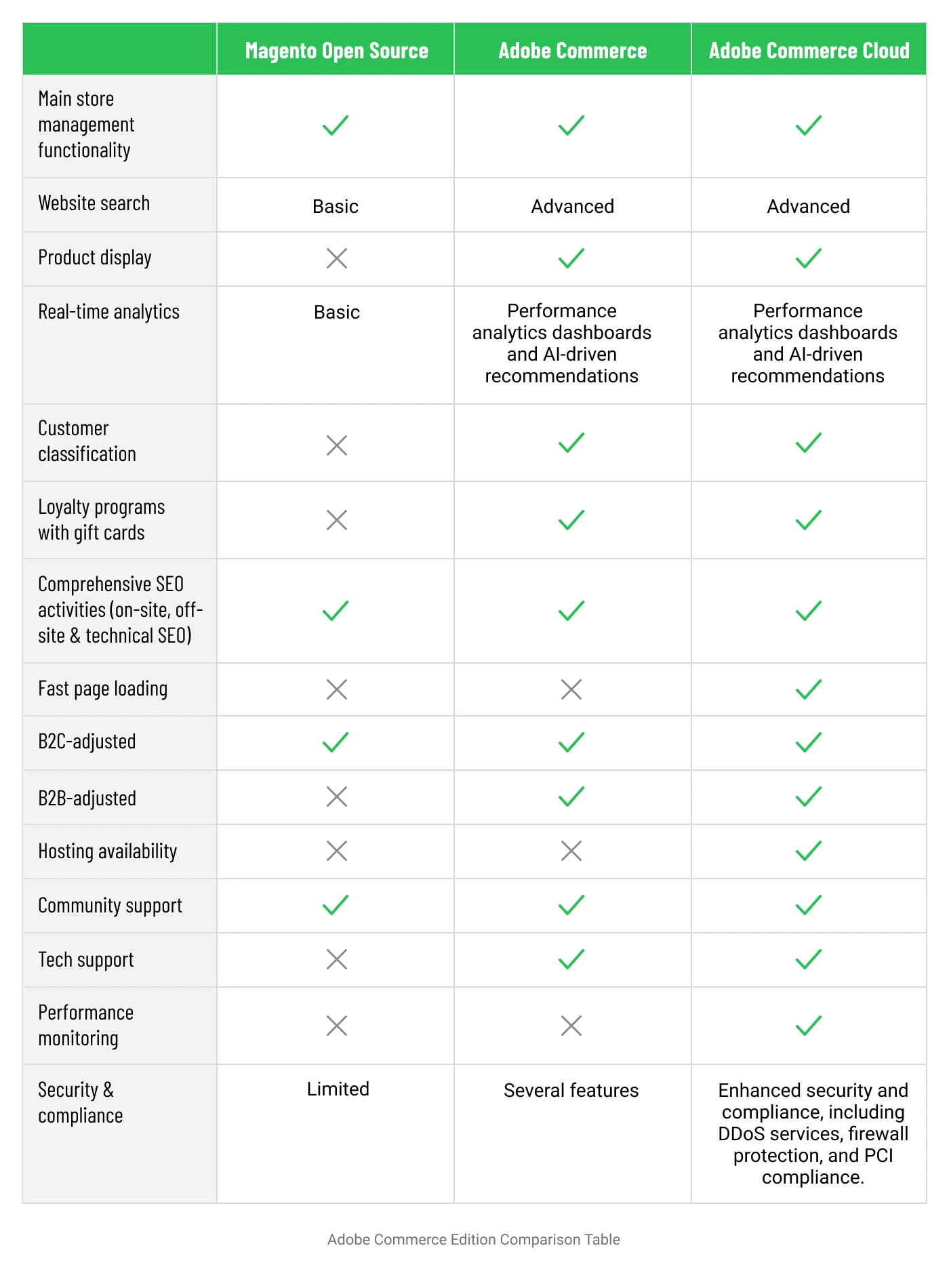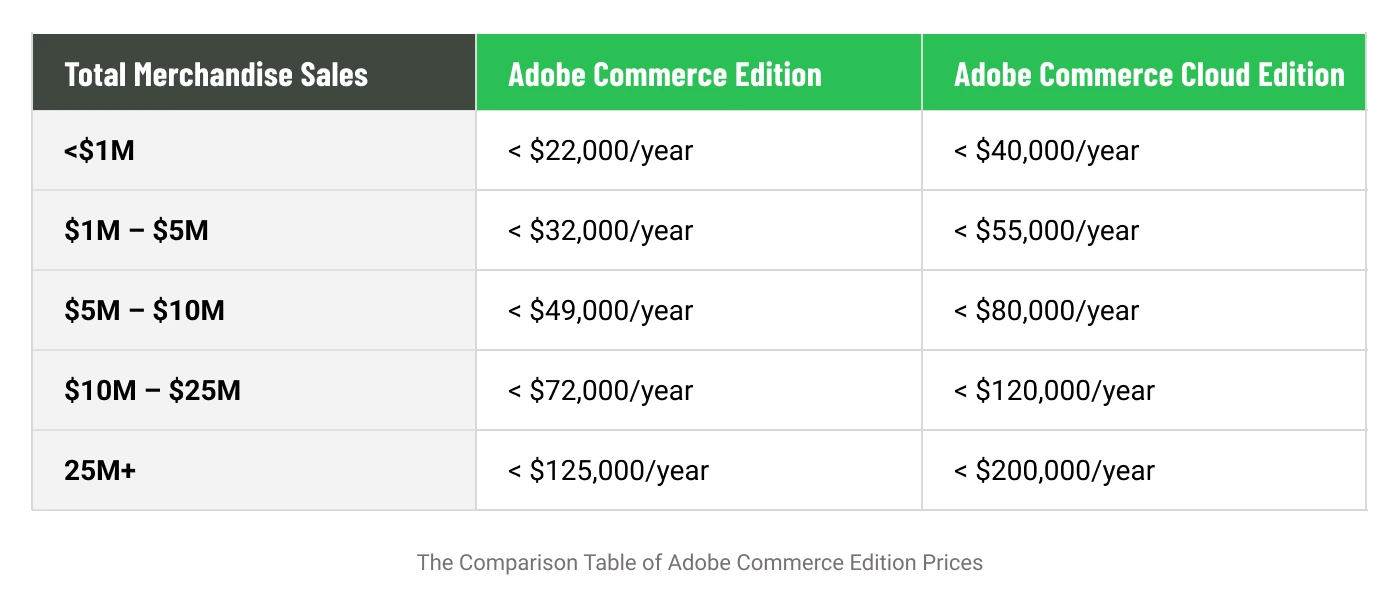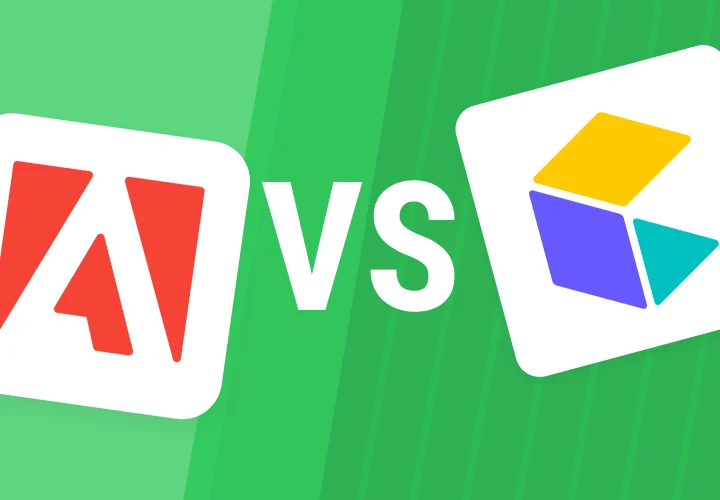Adobe Commerce Pricing in 2025: Which Edition to Choose and Happily Run The Store Without Exceeding the Budget
Table of contents
- Adobe Commerce Edition Breakdown: Which One to Choose?
- Magento Open Source Edition
- Adobe Commerce Edition
- Adobe Commerce Cloud Edition
- What Factors Affect Adobe Commerce’s Cost?
- Transactions
- Third-party vendors
- Custom development
- Design & UX improvements
- Marketing & SEO
- Content management
- Fulfillment services
- Security & compliance
- Performance monitoring & optimization
- Training & support
- Maintenance & updates
- On-premise hosting
- Data migration & management
- Choose the Edition that Fits Your Budget: Comparing Adobe Commerce Edition Prices
- Are You Ready to Launch Your Store on Adobe Commerce? Make It Flawless With Emerline!
- Summing Up
- Frequently Asked Questions about Adobe Commerce
- What is the pricing of a typical Adobe Commerce (Magento) project?
- What is the cost difference between Adobe Commerce Cloud and its on-premise versions?
- How much does it cost to host Adobe Commerce on-premise?
- Are there ongoing maintenance costs for Adobe Commerce?
- What support services are included in the Adobe Commerce subscription?
There are three editions available within the Adobe Commerce suite, each with its own pricing:
- Magento Open Source offers basic functionality that can’t be scaled or customized, suitable for small-sized businesses with limited budgets.
- Adobe Commerce provides broad customization opportunities, where each aspect of store management can be configured according to individual business needs.
- Adobe Commerce Cloud is a manageable service fully hosted on the cloud, which opens broad scalability opportunities for E-commerce stores.
Licensing costs are not the only factor affecting the finite pricing of the edition you choose. The cost of launching a store on Adobe Commerce is based on multiple factors, including your marketing goals, SEO, compliance practices, website tech support, as well as other factors, which will vary by business.
Finally, licensing costs are flexible enough for each edition and depend on your store's total merchandise sales. The larger the operation, the higher the price.
Adobe Commerce remains one of the frontrunners in the E-commerce market, with almost 670 million websites running on Magento (now known as Adobe Commerce). This platform is the top choice for businesses in various industries because it combines high performance, convenience, and rich functionality for back-office and front-office operations. A broad range of features and the ability to enhance the platform with custom modules make Adobe Commerce practically a universal solution for store owners.
In this article, we will perform an overview of Adobe Commerce, including its available editions and their prices, and help you determine why you should choose it for your enterprise.
Adobe Commerce Edition Breakdown: Which One to Choose?
There are three editions available within the Adobe Commerce suite. When choosing the edition for your online store, consider the following factors so you will adopt the best one for your needs:
- Your company’s size
- Tasks, operations, and/or processes you want to improve
- Data infrastructure maintenance costs you are ready to pay
Magento Open Source Edition
Formerly known as Community Edition, Magento Open Source is free (as the name suggests). This option has the basic functionality you need to start your online store, including manageable catalogs, configurable payments and checkouts, integrated shipping services, and more.
With this feature set, Magento Open Source is well-suited for small and medium-sized businesses. You can also enhance the platform’s basic functionality with paid and/or free extensions available in the official extension store and from third-party vendors.
However, even all these features won’t be enough in the long term to accommodate growing businesses needs. Magento Open Source is a perfect option if you are running a small business and aren’t planning to scale. But for scaling needs, you should consider paid editions.
Adobe Commerce Edition
Adobe Commerce was designed for medium-sized and large businesses, giving them practically limitless flexibility as they grow. Once they set up the store, they can customize it as needed for nearly any aspect of their operation.
For example, store owners can flexibly adjust customer segmentation to classify customers by various parameters for targeted promotions. Or, they can build up any loyalty program they need, with configurable rules and tiers, to reach a broader audience, acquire new customers, or narrow the existing clientele to particular segments. With customizable gift cards, they can provide personal rewards to each customer and thus nurture their engagement. Indeed, Adobe Commerce gives broad opportunities for E-commerce businesses!
Additionally, the offering includes:
- Community support for continuous guidance and troubleshooting
- Advanced security tools, such as two-factor authentication (2FA), security scan, access controls, session management, encryption, and more
- Scalable infrastructure
- Marketing automation and personalization tools that allow you to run targeted campaigns with AI-based recommendations
- Integration with third-party gateways
Perhaps the only downside for some will be the inevitable infrastructure maintenance costs that come with the edition’s price. As your business grows, estimating and forecasting these expenses becomes more complex, complicating budget planning. If you want predictable budgets throughout your business operation, Adobe Commerce Cloud Edition should be your choice.
Adobe Commerce Cloud Edition
Adobe Commerce Cloud is a managed, fully cloud-hosted solution predominantly for large enterprises ready to pay a higher price to accommodate their scalability needs. Apart from peerless performance capabilities granted by cloud technology, you will benefit from advanced protection solutions. The latter include multi-factor authentication (MFA) controls, regular security updates, cloud onboarding guidance, PCI compliance, DDoS services, a web application firewall, and more.
With Adobe Commerce Cloud, your scalability needs are always accommodated! Elastic infrastructure enables dynamic adjustments of your IT resources, and scaling is automated. The solution also has pre-built connectors to facilitate integrations with third-party extensions.
As already mentioned, the only disadvantage is the price (we will cover the price topic further in the article). If Adobe Commerce Cloud pricing doesn’t match your budget, an alternative is to find the right compromise between scalability needs and infrastructure maintenance costs.
To help you effectively evaluate the options available within the Adobe Commerce suite, we prepared the following comparison table:

What Factors Affect Adobe Commerce’s Cost?
Apart from features, functionalities, and opportunities, price is a key factor businesses consider when choosing an Adobe Commerce edition. The devil is in the details, meaning that besides the license fee, many other factors contribute to your solution's final cost.
There are several major factors that can affect the price of Adobe Commerce. Your business goals will determine which factors will contribute to your cost. For your convenience, we divided them into categories.
Transactions
- Transaction fees that vary among payment gateway providers
- Additional fees that come with advanced payment and/or fraud monitoring tools
- Transaction fees charged by third-party services or extensions
Third-party vendors
- Third-party extensions’ purchase and updating costs
- Subscription fees charged by premium extensions
Custom development
- Costs associated with hiring dedicated specialists to develop custom modules and/or features
- Integration expenses that vary, depending on the integration’s type (third-party API, ERP, CRM, or another)
- Software maintenance costs
Design & UX improvements
- Costs associated with design customizations, such as designing a new theme from scratch or updating the existing one
- Continuous design testing and optimization costs
Marketing & SEO
- Subscription fees charged by SEO, email marketing, marketing automation, and other tools you use
- Costs associated with marketing campaigns
Content management
- Costs associated with hiring dedicated content writers
- Potential costs of using content management solutions
Fulfillment services
- Shipping providers and delivery service fees
- Third-party logistics service fees
Security & compliance
- Additional costs that come with advanced security measures you implement, such as firewalls, SSL certificates, access monitoring, etc
- Compliance audit and maintenance costs
Performance monitoring & optimization
- CDN integration and server optimization fees
- Costs associated with the use of website performance optimization tools
Training & support
- Costs associated with staff onboarding and further training
- Technical support fees that vary depending on the provider (Adobe or third-party)
Maintenance & updates
- Expenses related to various maintenance procedures, such as feature and security updates
- Website monitoring costs
On-premise hosting
- Hosting services’ costs, including server management, bandwidth, backup, and storage
Data migration & management
- Costs associated with the migration of the existing website to Adobe Commerce
- Regular expenses related to data management and optimization
With all these factors enumerated, you can now compose a comprehensive checklist to ensure you don’t forget anything when planning your budget. Add the license fee of the chosen Adobe Commerce edition to these, and you will have a predictable image of your expenses.
Choose the Edition that Fits Your Budget: Comparing Adobe Commerce Edition Prices
Besides the pricing factors, the one factor that stands out is the value of your gross merchandise. It affects the license cost itself. Remember that license costs may change, depending on Adobe’s business model.

Are You Ready to Launch Your Store on Adobe Commerce? Make It Flawless With Emerline!
Emerline provides a complete set of Adobe Commerce development services, including design, development, consulting, and migration. You can request our professional assistance throughout the entire website delivery lifecycle, or ask us to join you at any particular process step. We can also help you plan your budget by consulting with you on the optimal solutions to fit your budget.
We’ve worked with Adobe Commerce for over a decade, constantly adjusting to its latest solutions and developments. We know all the ins and outs of this platform. The delivery centers in Europe and the USA are at your service, ready to deliver you a feature-rich Adobe Commerce solution within seamless delivery workflows.
Summing Up
Choosing the most suitable Adobe Commerce Edition for your business is not as challenging as it may seem. To make a reasonable choice, you should ask yourself what you want to accomplish with the website, whether you plan to scale your business in the foreseeable future, and what you can afford with your budget. These questions will help you make the right decision.
Frequently Asked Questions about Adobe Commerce
What is the pricing of a typical Adobe Commerce (Magento) project?
The average cost of an Adobe Commerce (formerly, Magento) project starts from $50,000 and may reach $500,000 and higher, depending on the project's size and complexity. The final price is also based on licensing, development, design, integration, customization, initial setup, and other costs. Smaller projects typically require minimal customization, so their cost is likely to be on the lower end of this price range, whereas large projects require extensive customized enterprise solutions and tend to be on the higher end.
What is the cost difference between Adobe Commerce Cloud and its on-premise versions?
Adobe Commerce Cloud is generally more expensive than the on-premise version. The cloud version includes managed hosting services, automatic updates, and enhanced security features, all factors that affect its final cost. However, the exact cost difference cannot be determined, as it depends on the specific size and needs of each particular business.
How much does it cost to host Adobe Commerce on-premise?
Hosting Adobe Commerce on-premise entails costs related to server infrastructure, bandwidth, storage, security measures, and IT staff responsible for server management and maintenance. These costs vary, depending on the hosting provider and your business requirements.
Are there ongoing maintenance costs for Adobe Commerce?
Yes, Adobe Commerce has ongoing maintenance costs. These include applying security patches, platform updates, performance optimization, and resolving technical issues. Maintenance can be managed in-house or outsourced to a third-party service provider.
What support services are included in the Adobe Commerce subscription?
Adobe Commerce subscriptions typically offer 24/7 support for technical issues, account management, and access to extensive documentation and resources. Adobe Commerce Cloud users also benefit from managed hosting support.
Updated on Mar 17, 2025





